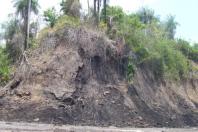Tar sands development and protests gather steam ... in Utah
Oilsands development and protests gather steam ... in Utah
Junior oilsands producer U.S. Oil Sands Inc. has just secured $80 million in financing from three private investors that will be partly used to develop the initial phase of an oilsands project in Utah that could eventually produce 20,000 barrels of oil a day.
The Calgary-based company expects to produce 2,000 barrels a day in the next year or two from property in the Rocky Mountains it has held since 2005.
Oilsands are synonymous with Alberta, but deposits exist in many places in the world.
The realization of what would be the first oilsands mine in the United States hinges on a successful commercial application of the citrus-based biosolvent U.S. Oil Sands says can extract oil without toxic tailings ponds. If the innovation is proven in the field, the company is optimistic the process could be applied to much smaller pools of heavy oil beyond the massive resource that is now producing more than two million barrels a day in northern Alberta.
"This project has been a long time coming but we certainly believe it's worth the time to get it right," Cameron Todd, chief executive of U.S. Oil Sands, said on a conference call with investors Monday. "We've done a lot of piloting and development work. We're ready for prime time."
With first production on the horizon, U.S. Oil Sands better get ready for the media glare.
As an Albertan, Todd is well aware of the scrutiny - and the celebrity activists - that come with being a "prime time" player in the oilsands.
While actors, singers and environmentalists regularly rail against oilsands development and the much-delayed Keystone XL pipeline that would move bitumen from Alberta to Texas, people in Utah have been fighting a lower profile battle against companies hoping to develop the shale oil resource. They've held sit-ins and challenged the development plans in court. They appear to have slowed down, but not stopped, the industry and Todd has said he doesn't believe the legal challenges would halt the project, known as PR Spring.
Utah is the most arid state in the U.S. and there is concern from some in the state about the impact of large-scale, waterintensive oil development. There are more than 50 identified oilsands deposits in the state that contain an estimated 20 to 32 billion barrels of bitumen in place.
U.S. Oilsands contends it has a technology to avoid significant water consumption.
"We believe we are on the cutting edge of oilsands extraction methodology," Todd said of the technology that uses d-limonene, found in orange peels, more than water to extract crude oil. "We are poised to commercially demonstrate this to the rest of the world." Environmentalists in Utah contend the technology is still unproven.
Todd became CEO at U.S. Oil Sands in 2011 after having spent part of his career with oilsands producer Connacher Oil and Gas, so he is familiar with technically challenging, politically sensitive oil developments. Other prominent executives on the board include Ed Chwyl, former CEO of Tarragon Oil & Gas, and Verne Johnson, former CEO of ELAN Energy. A number of new directors were added to the board in conjunction with the financing deal that will close next month.
The company turned its focus to Utah after reviewing pricey opportunities in Alberta.
The potential of the shale oil resource in the mountains of Nevada, Colorado and Utah has long been known to the industry. As far back as 1919, National Geographic magazine noted the region had the potential to provide "supplies of gasoline which can meet any demand ... for generations to come." Generations have passed but the resource potential has never been realized. Today, Utah produces about 90,000 barrels of oil a day and has proved oil reserves of 504 million barrels.
U.S. Oilsands, which trades on the TSX Venture Exchange in Toronto, has said the PR Spring development is a $50-million project. The company has acquired 32,000 acres of land in the Uinta Basin - the largest oilsands holding in the state.
The U.S. Bureau of Land Management has approved more than 800,000 acres of land for oilsands and oil shale development in
Utah, Wyoming and Colorado known as the Green River Formation. The U.S. Geological Survey estimates between 353 billion and 1.146 trillion barrels of oil in the Green River Formation's oil shale deposits "have a high potential for development."
There are more than two trillion barrels of bitumen in the ground in Alberta but it amounts to 169 billion barrels of reserves. The massive mining projects - some date to the 1960s - typically produce hundreds of thousands of barrels a day while the numerous in situ projects based on pad drilling are closer in scale to the project U.S. Oil Sands has proposed. Utah is never going to rival Alberta as an oil producer but it certainly has the potential to develop an industry and a celebrity following of its own - for better or worse.
Stephen Ewart is a Calgary Herald columnist sewart@calgaryherald.com
http://www.calgaryherald.com/business/Ewart+Oilsands+development+protests+gather+steam+Utah/8926211/story.html


